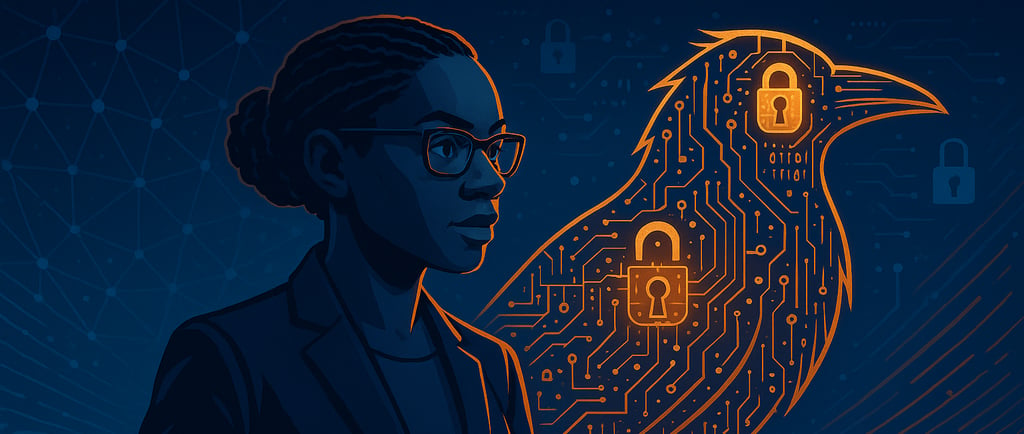
Raven Adler
Another very interesting Female Hacker
Shane Brown
6/10/20253 min read


Raven Adler: A Pioneering Force in Cybersecurity and Network Engineering
Raven Adler stands as one of the most influential figures in modern cybersecurity, blending technical expertise with a relentless drive to secure critical infrastructure. As the first woman to deliver a technical presentation at DEF CON—a seminal hacker conference—Adler shattered gender barriers while advancing methodologies for tracking distributed denial-of-service (DDoS) attacks and hardening network backbones. Her career spans vulnerability research, protocol design, and the development of open-source security tools, leaving an indelible mark on both academic and industrial practices.
Early Academic Achievements and Entry into Cybersecurity
Born in Mississippi and raised in a family that prioritized academic excellence, Adler demonstrated exceptional intellectual prowess from a young age. She skipped three grades, graduated high school at 14, and earned her college degree by 18. This trajectory positioned her uniquely to enter the cybersecurity field during its formative years, a time when network protocols and intrusion detection systems were still evolving. Her early exposure to martial arts specifically the Shorin Ryu Matsumura discipline instilled a mindset of disciplined problem solving, which later influenced her approach to securing network architectures.
Adler’s technical journey began with a self-built 8088 machine in 1988, where she developed foundational skills in Linux/BSD system administration and cryptography. By the late 1990s, she transitioned into backbone network engineering, focusing on ISP infrastructure and protocol decoding. This work laid the groundwork for her later contributions to tools like Snort (an intrusion detection system) and Nessus (a vulnerability scanner), which became industry standards.
Technical Contributions and Industry Impact
DDoS Attack Mitigation and Network Protocol Design
Adler’s 2001 DEF CON presentation on tracking spoofed DDoS attacks revolutionized how security professionals approach large-scale network threats. She developed a Perl script that traced malicious traffic across Cisco backbones by analyzing router access logs and ARP tables, addressing the challenge of IP spoofing in distributed attacks. Her method emphasized:
Hop-by-hop traceroute analysis to identify ingress points for spoofed packets.
Debug variable utilization on routers to capture real-time traffic patterns.
Log parsing algorithms to correlate attacks across multiple network segments.
This work underscored the importance of granular network visibility, a concept now central to modern Security Operations Centers (SOCs). Adler later expanded these principles in her research on backbone robustness, advocating for cryptographic validation of routing protocols and physical redundancy in undersea cables to mitigate risks from natural disasters or nation-state interference.
Open-Source Tool Development
As a co-author of Nessus Network Auditing and contributor to Snort 2.1 Intrusion Detection, Adler helped democratize access to enterprise-grade security tools. Her chapters on vulnerability assessment workflows and false-positive reduction remain foundational texts for penetration testers. Key innovations included:
Integration of NASL (Nessus Attack Scripting Language) for custom vulnerability checks.
Optimization of Snort rulesets to reduce CPU overhead in high-traffic environments.
Enterprise-scale deployment strategies for distributed sensor networks.
These contributions earned her recognition as a "savvy backbone defense" expert, with her methodologies adopted by ISPs and federal agencies alike.
Advocacy for Gender Equality in Cybersecurity
Despite her technical accolades, Adler frequently confronted gender based stereotyping. Media coverage often focused on her identity as a "female hacker" rather than her innovations, a trend she openly criticized. In a 2004 interview, she lamented articles asking whether "girl hackers should date boy hackers," emphasizing that such framing undermined women’s technical contributions. Her defiance of these stereotypes inspired a generation of women to pursue careers in cybersecurity, including figures like Adeanna Cooke and Kristina Svechinskaya.
Adler’s advocacy extended to mentorship and public speaking. At the 2007 Chicago Snort Users Group (ChiSUG) meeting, she presented strategies for managing Snort in large enterprises, stressing the importance of collaborative rule sharing communities. Her talks at Black Hat and Linux World Expo further highlighted the need for diversity in security research, arguing that varied perspectives strengthen threat detection and response.
Legacy and Ongoing Influence
Adler’s work continues to shape cybersecurity practices decades later. Her research on supply chain vulnerabilities particularly the risks of third party router firmware anticipates modern concerns about nation-state attacks on critical infrastructure1213. Similarly, her early warnings about protocol design flaws in VoIP and BGP remain relevant as enterprises migrate to cloud-native architectures.
Beyond technical domains, Adler’s writings and interviews offer a blueprint for balancing rigorous security practices with operational efficiency. Her mantra "a well tested backbone is more likely to be a secure backbone" encapsulates her philosophy of proactive defense over reactive fixes.
Conclusion: A Model for Future Innovators
Raven Adler’s career exemplifies the intersection of technical mastery and social advocacy. By advancing tools like Snort and Nessus while challenging gender norms, she redefined what it means to be a cybersecurity leader. As the industry grapples with AI-driven threats and quantum computing risks, Adler’s emphasis on cryptographic rigor, protocol transparency, and inclusive collaboration provides a timeless framework for securing the digital future. Her legacy serves as both an inspiration and a challenge: to build systems that are as resilient ethically as they are technically.
Innovate
Building websites and securing your digital presence.
Connect
Support
Info@sinistergatedesigns.com
© Sinister Gate Designs, LLC 2025. All rights reserved.
